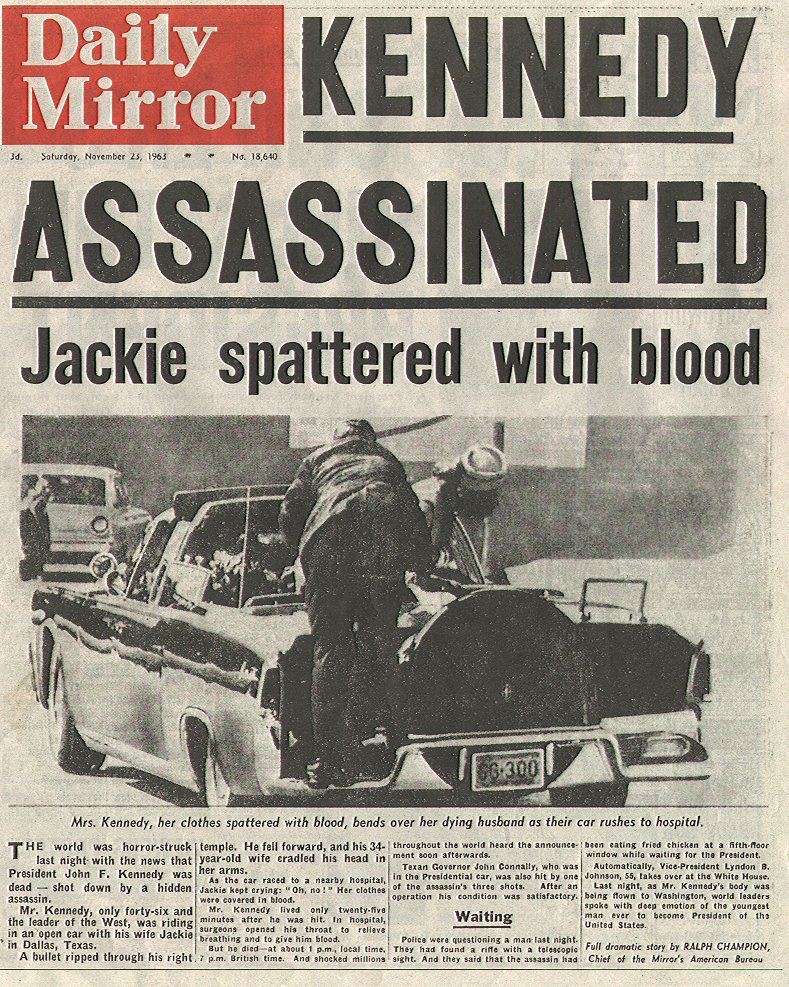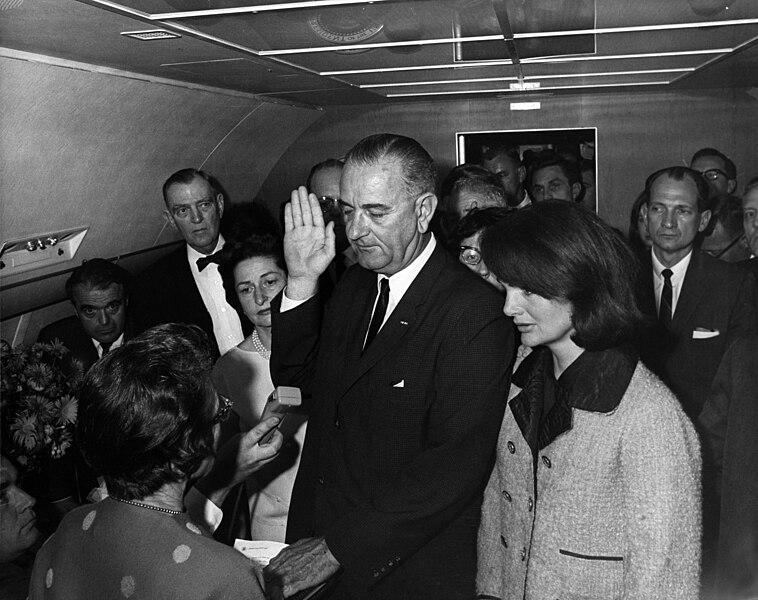
John Fitzgerald Kennedy, the Thirty Fifth President of the United States was assassinated at 12:30 p.m. Central Standard Time (18:30 UTC) on Friday, November 22, 1963, in Dealey Plaza, Dallas, Texas. Kennedy was fatally shot while traveling with his wife Jacqueline, Texas governor Johjn Connally, and the latter's wife, Nellie, in a Presidential Motorcade.
The ten-month investigation of the Warren Commission of 1963–1964 concluded that the President was assassinated by Lee Harvey Oswald acting alone and that Jack Ruby acted alone when he killed Oswald before he could stand trial. These conclusions were initially supported by the American public; however, polls conducted from 1966 to 2004 found that as many as 80 percent of Americans have suspected that there was a plot or cover-up.

Contrary to the Warren Commission, the United States House Select Committee on Assassinations (HSCA) in 1979 concluded that President John F. Kennedy was probably assassinated as a result of a conspiracy. The HSCA found both the original FBI investigation and the Warren Commission Report to be seriously flawed. While agreeing with the Commission that Oswald fired all the shots which caused the wounds to Kennedy and Governor Connally, it stated that there were at least four shots fired and that there was a "high probability" that two gunmen fired at the President. No gunmen or groups involved in the conspiracy were identified by the committee, but the CIA, Soviet Union, organized crime and several other groups were said to be not involved, based on available evidence. The assassination is still the subject of widespread debate and has spawned numerous conspiracy theories and alternative scenarios.

(Aerial view of Dealey Plaza showing route of President Kennedy's motorcade)
At 12:30 P.M. CST, as Kennedy's uncovered limousine entered Dealey PLaza and slowly approached the plaza, which included the Texas School Book Depository, Nellie Connally, then the First Lady of Texas, turned around to Kennedy, who was sitting behind her, and commented, "Mr. President, you can't say Dallas doesn't love you," which President Kennedy acknowledged.
When the Presidential limousine turned left and passed the Depository and continued down Elm Street, shots were fired at Kennedy; a clear majority of witnesses recalled hearing three shots. A minority of the witnesses did recognize the first gunshot blast they heard as a weapon blast, but there was hardly any reaction from a majority in the crowd or riding in the motorcade itself to the first shot, with many later saying they heard what they first thought to be a firecracker or the exhaust backfire of a vehicle just after the president started waving.

(This photograph by Associated Press photographer Ike Altgens captures President Kennedy's limousine as it proceeds down Elm Street in Dealey Plaza in Dallas, Texas on November 22, 1963. Altgen testified that he took it after the first shot and before any subsequent shots were fired. President Kennedy (his face blocked by the limousine's rearview mirror) has been shot through the throat, and his clenched left fist is raised toward his throat. Mrs. Kennedy's gloved hand is on his arm. Governor Connally, seated in front of the President and turning to his right to look at him, has also been shot. In the front seat are two Secret Service agents. At the top right, an agent standing on the running board of the followup car looks back toward the Texas School Book Depository. In the background is the entrance to the Depository. The photo is significantly cropped here, showing only the left third of the original; note that this gives misleading impressions of where the photographer was standing and in what directions the spectators were looking.)
Within one second of each other, President Kennedy, Governor Connally, and Mrs. Kennedy, all turned abruptly from looking to their left to looking to their right, between Zapruder Film frames 155 and 169. Connally, like the president a WWII military veteran (and unlike the president, a longtime hunter), testified he immediately recognized the sound of a high-powered rifle, then he turned his head and torso rightward attempting to see President Kennedy behind him. Connally testified he could not see the president, so he then started to turn forward again, and was hit in his upper right back by a bullet, fired in a gunshot that Connally testified he did not hear the muzzle blast from. He then shouted, "Oh, no, no, no. My God. They're going to kill us all!"
Mrs. Connally testified that right after hearing a first loud, frightening noise that came from somewhere behind her and to her right, she immediately turned towards President Kennedy and saw him with his arms and elbows already raised high with his hands already close to his throat. She then heard another gunshot and John Connally started yelling. Mrs. Connally then turned away from President Kennedy towards her husband, then another gunshot sounded and she and the limousine's rear interior were now covered with fragments of bone, blood, and brain matter.

Kennedy Declared Dead in Emergency Room!
At 1:00 p.m., CST (19:00 UTC), after all heart activity had ceased and after a priest administered the last rites, the President was pronounced dead. "We never had any hope of saving his life," one doctor said. The Rev. Oscar L. Huber, the Priest who administered the last rites to Kennedy told The New York Times that the President was already dead by the time Huber had arrived at the hospital, and he had to draw back a sheet covering the President's face to administer the sacrament of Extreme Unction. Kennedy's death was officially announced by White House Acting Press Secretary Malcolm Kilduff at 1:33 p.m. CST (19:33 UTC). Governor Connally, meanwhile, was taken to emergency surgery, where he underwent two operations that day.
A few minutes after 2:00 p.m. CST (20:00 UTC), and after a confrontation between Dallas police and Secret Service agents, Kennedy's body was placed in a casket and taken from Parkland Hospital and driven to Air Force One. The casket was then loaded aboard the airplane through the rear door, where it remained at the rear of the passenger compartment, in place of a removed row of seats. The body was removed before a forensic examination could be conducted by the Dallas County coroner (Earl Rose), which violated Texas state law (the murder was a state crime and occurred under Texas legal jurisdiction). At that time, it was not a federal offense to kill the President of the United States, although it was a federal crime to conspire to injure a federal officer while he was acting in the line of duty.
Vice President Johnson (who had been riding two cars behind Kennedy in the motorcade through Dallas and was not injured) became President of the United States upon Kennedy's death. At 2:38 p.m. Johnson took the oath of office on board Air Force One just before it departed from Love Field.

(Lyndon B Johnson is sworn in as U.S. President aboard Air Force One in Dallas)
Sate Funeral of John F Kennedy
The President's body was brought back to the White House and placed in the East Room in a closed casket for 24 hours but was opened privately and briefly viewed during this time by the Kennedy family and some close friends. The Sunday following the assassination, his flag-draped closed casket was moved to the Capital for public viewing. Throughout the day and night, hundreds of thousands lined up to view the guarded casket.
Representatives from over 90 countries, including the Soviet Union, attended the funeral on November 25 (which was John Kenndy Jnr's third Birthday third birthday in office). After the service, the casket was taken by Caisson to Arlington National Cemetary for burial.
(Photo, taken during the funeral, now on display at the Arlington Cemetery, VA)
Lee Harvey Oswald
Lee Harvey Oswald, reported missing to the Dallas police by Roy Truly, his supervisor at the Depository, was arrested approximately 40 minutes after the assassination for killing a Dallas police officer, J.D. Tippit, who had spotted Oswald walking along a sidewalk in the residential neighborhood of Oak Cliff three miles from Dealey Plaza. Officer Tippit had earlier received a radio message which gave a description of the suspect being sought in the assassination and called Oswald over to the patrol car. After an exchange of words, Tippit got out of the car and Oswald shot him four times. Oswald was captured in a nearby Movie Theatre after he was seen sneaking into the theater without buying a ticket.
Oswald resisted, attempting to shoot the arresting officer, M.N. McDonald, with a pistol, and was struck and forcibly restrained by the police. He was charged with the murders of Kennedy and Tippit later that night. Oswald denied shooting anyone and claimed he was a patsy who was arrested because he had lived in the Soviet Union. Oswald's case never came to trial because two days later, while being escorted to a car for transfer from Dallas Police Headquarters to the Dallas County Jail, he was shot and killed by Dallas nightclub owner Jack Ruby, live on American television.



2025 New batch of files do they tell us anything new? DJT did this cause didn't do before? JFK Researchers /Debunkers went thru files with fine tooth comb ?1.Who all were in dealey plaza A)Marita Lorenz said Frank Sturgis/G Hemming,Ozzy,(other men )all left Bosch apt in 2 cars went to dallas tx ?B.) Tosh said He in dealey plaza with Sergio?That he flew in many men __?C.)Johnny Roselli/FRiedman left LasVegas (16-18)Nov1963 to Scottsdale Az.Jeanne Carmen said Roselli told her to leave LA 8-5-1962(after MMdod.)D.)Hemming stated His Men did job (jfkeducforum)E.)Luis Posada stated he was in dallas so was Bosch. Luis said _Suton Files apart of the _?F.)SK stated Kaiser wasn't home 11-22-1963.G.)Pix Resembles E.H.H.in dealey plaza.E.H.H. son stated dad stated he was benchwarmer &E.H.H. in watergate?H.)Jim Braden aka Eugene Hale Brading in dealey plaza? Supposedly visiting offices of Hunt OIL?(Jim Braden, Morgan Brown, Roger Bauman and Duane Nowlin checked into the Cabana Motor Hotel )i.)Loran Hall arrest 18 oct same day LHO start job?John Pappas said mom Ann said Loran wasn't home 11-22-1963?GPH stated Loran in dallas? J.)James Sutton Files stated he was in dallas with C.Nicoletti/J Roselli&others(chaunceyHolt?)? K.) Lbj with presidential limosine motorcade&SSA? ?L.) Richard Nixon in dallas tx?M.) maybe jack ruby? N.) james Tague O.) DPD?Agents?P.)can you name a person that claim they were in dealey plaza dallas texas 11-22-1963?Which Ones benefit or gain from _?Motive Means Opportunity _? will ever know truth? Would gatekeepers have all files to distract from truth?
ReplyDelete